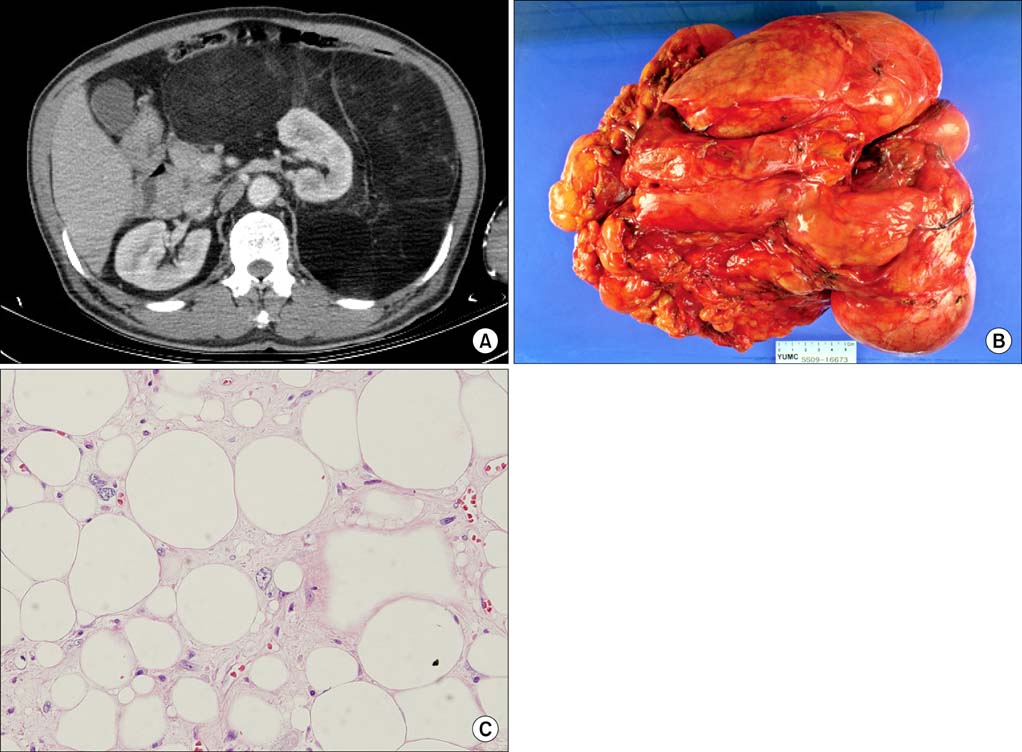Korean J Urol.
2010 Aug;51(8):579-582. 10.4111/kju.2010.51.8.579.
Retroperitoneal Giant Liposarcoma
- Affiliations
-
- 1Department of Urology, Urological Science Institute, Yonsei University Health System, Seoul, Korea. hanwk@yuhs.ac
- 2Department of Pathology, Yonsei University Health System, Seoul, Korea.
- KMID: 1997028
- DOI: http://doi.org/10.4111/kju.2010.51.8.579
Abstract
- Retroperitoneal liposarcoma is an infrequent, locally aggressive malignancy. We report two cases of huge retroperitoneal liposarcomas. The presence of a palpable abdominal mass was a common symptom of the two patients. Preoperative imaging study showed huge retroperitoneal tumors. Both patients underwent complete surgical resections, and a negative microscopic margin was achieved in both cases. The histopathologic diagnosis was a well-differentiated retroperitoneal liposarcoma. Neither of the two patients developed a recurring tumor during the 1.5 years of follow-up.
Keyword
MeSH Terms
Figure
Reference
-
1. Perez EA, Gutierrez JC, Moffat FL Jr, Franceschi D, Livingstone AS, Spector SA, et al. Retroperitoneal and truncal sarcomas: prognosis depends upon type not location. Ann Surg Oncol. 2007. 14:1114–1122.2. Seo IY, Won HS, Kim JS, Kim HS, Rim JS. A case of recurrent liposarcoma in retroperitoneum. Korean J Urol. 1994. 35:1375–1378.3. McCallum OJ, Burke JJ 2nd, Childs AJ, Ferro A, Gallup DG. Retroperitoneal liposarcoma weighing over one hundred pounds with review of the literature. Gynecol Oncol. 2006. 103:1152–1154.4. Lewis JJ, Leung D, Woodruff JM, Brennan MF. Retroperitoneal soft-tissue sarcoma: analysis of 500 patients treated and followed at a single institution. Ann Surg. 1998. 228:355–365.5. Choi EH, Yoon JB. Retroperitoneal liposarcoma (pleomorphic type): a case report. Korean J Urol. 1996. 37:1187–1190.6. Bautista N, Su W, O'Connell TX. Retroperitoneal soft-tissue sarcomas: prognosis and treatment of primary and recurrent disease. Am Surg. 2000. 66:832–836.7. Jaques DP, Coit DG, Hajdu SI, Brennan MF. Management of primary and recurrent soft-tissue sarcoma of the retroperitoneum. Ann Surg. 1990. 212:51–59.8. Yol S, Tavli S, Tavli L, Belviranli M, Yosunkaya A. Retroperitoneal and scrotal giant liposarcoma: report of a case. Surg Today. 1998. 28:339–342.9. Shim JE, Lee MY, Kim CM, Jung UY, Na HJ. A case of retroperitoneal liposarcoma. Korean J Urol. 1984. 25:369–371.10. Porter GA, Baxter N, Pisters PW. Retroperitoneal sarcoma: a population-based analysis of epidemiology, surgery, and radiotherapy. Cancer. 2006. 106:1610–1616.



